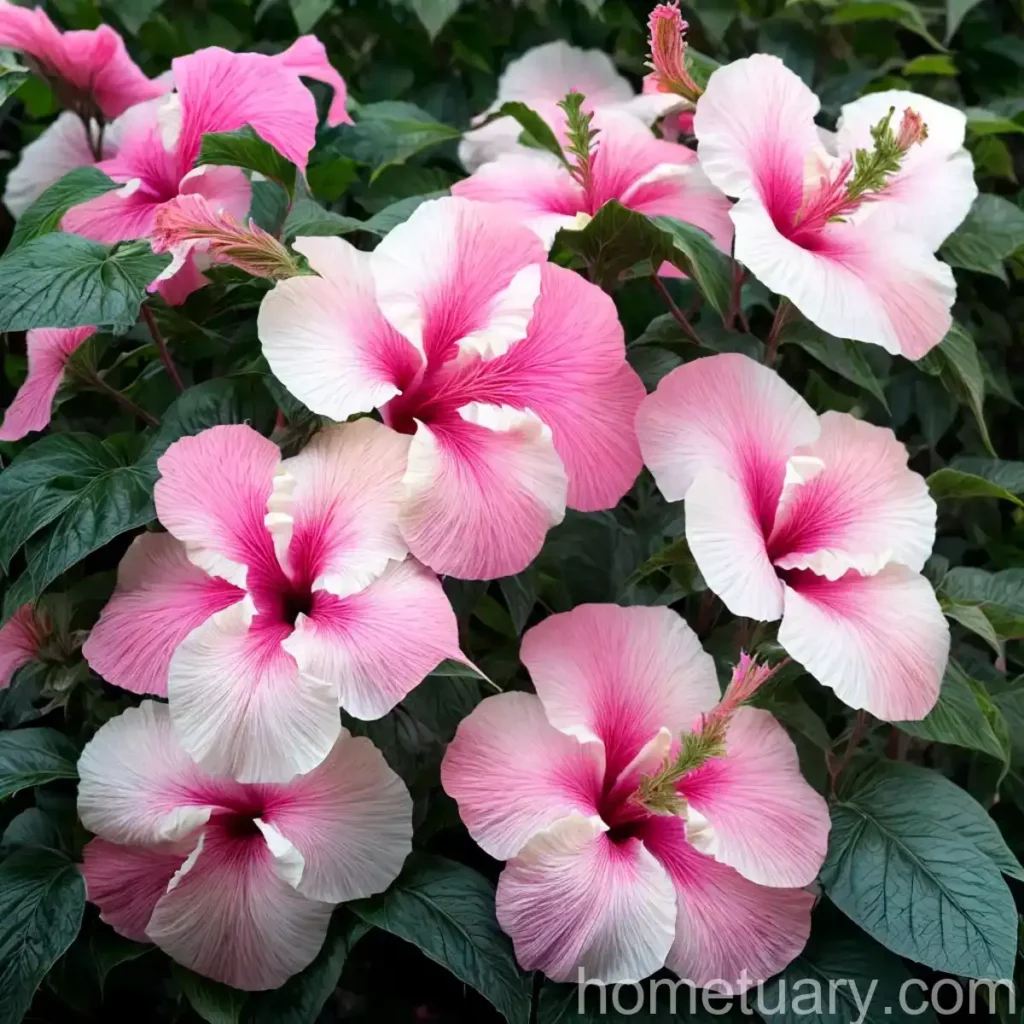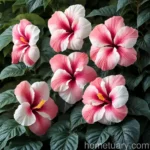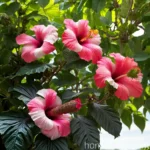The Fascinating World of Hardy Hibiscus (Hibiscus moscheutos ‘Luna Pink Swirl’)
In the realm of ornamental horticulture, one of the most captivating and visually striking plant species is the hardy hibiscus, scientifically known as Hibiscus moscheutos ‘Luna Pink Swirl’. This plant is renowned for its stunning flowers, low maintenance requirements, and adaptability to various environmental conditions. In this comprehensive guide, we will delve into the multifaceted aspects of this remarkable plant, covering its cultural requirements, uses, propagation techniques, common diseases and pests, as well as fascinating botanical insights. Whether you are a seasoned gardener or a novice plant enthusiast, this article will equip you with the knowledge needed to cultivate and appreciate the captivating Luna Pink Swirl hibiscus to its fullest potential.
What is Hardy Hibiscus (Hibiscus moscheutos ‘Luna Pink Swirl’)?
Hardy hibiscus, also known as swamp rose mallow, is a herbaceous perennial plant that belongs to the Malvaceae family. The ‘Luna Pink Swirl’ variety of Hibiscus moscheutos is particularly cherished for its large, showy flowers that boast delicate pink hues and distinctive swirl patterns. This plant is native to wetland areas in the eastern and southeastern regions of the United States, where it thrives in marshes, swamps, and along the edges of ponds and rivers.
One of the most alluring features of the Luna Pink Swirl hibiscus is the impressive size of its flowers, which can span up to 8-12 inches in diameter, making it a spectacular addition to any garden or landscape. Its robust and vigorous growth habit, coupled with its ability to withstand both high heat and humidity, renders it an ideal ornamental plant for various climatic zones.
Key Takeaways
Before delving into the specific aspects of culture, uses, and maintenance of the hardy hibiscus ‘Luna Pink Swirl’, let’s highlight some key takeaways about this remarkable plant:
- The ‘Luna Pink Swirl’ is a variety of Hibiscus moscheutos, a herbaceous perennial plant known for its large, captivating flowers.
- It is native to wetland areas in the eastern and southeastern United States and thrives in marshy, aquatic environments.
- The plant is adorned with spectacular 8-12 inch pink-hued flowers that exhibit distinct swirl patterns, adding a touch of elegance to any garden or landscape.
Now, let’s explore the intricacies of nurturing and enjoying the ‘Luna Pink Swirl’ hardy hibiscus to its fullest potential.
Culture
Water
Being native to wetland environments, the ‘Luna Pink Swirl’ hardy hibiscus thrives in moist to wet soil conditions. It is essential to ensure consistent soil moisture, especially during the plant’s active growth phase and flowering period. Regular watering is crucial, particularly during dry spells or in regions with hot summer climates. An inch of water per week is a good rule of thumb for ensuring adequate moisture levels. For container-grown hardy hibiscus, it is important to monitor the soil moisture levels to prevent it from drying out.
Sunlight
The ‘Luna Pink Swirl’ hibiscus flourishes in full sun to partial shade. While it displays optimal growth and flowering potential in full sun conditions, it can also tolerate partially shaded areas, making it a versatile choice for various garden settings. However, to ensure robust flowering and overall plant vigor, providing at least 6-8 hours of direct sunlight is recommended.
Soil
Hardy hibiscus ‘Luna Pink Swirl’ prefers well-draining, fertile, and slightly acidic soil with a pH range of 6.0 to 6.5. It can adapt to a wide range of soil types, including loamy, sandy, or clay soils, as long as they provide good drainage and nutrient availability. Prior to planting, incorporating organic matter such as compost or well-rotted manure into the soil can enhance its structure, fertility, and water retention capacity, contributing to the plant’s overall health and vigor.
Uses
The ‘Luna Pink Swirl’ hardy hibiscus boasts a myriad of uses, making it a highly versatile and sought-after plant for various landscaping and ornamental purposes. Some of its primary uses include:
-
Garden Ornament: Whether planted as a standalone specimen or incorporated into mixed perennial borders, the ‘Luna Pink Swirl’ hibiscus serves as a captivating focal point in garden landscapes. Its large, elegant flowers and lush foliage contribute to its visual appeal, adding a touch of vibrancy and elegance to garden settings.
-
Wetland Restoration: Given its natural affinity for moist, marshy environments, the ‘Luna Pink Swirl’ hibiscus is a valuable asset for wetland restoration and conservation efforts. It can be utilized in the re-establishment of native plant communities in wetland habitats, contributing to the enhancement of ecological diversity and sustainability.
-
Pollinator Attraction: The abundant nectar and pollen produced by the ‘Luna Pink Swirl’ hibiscus flowers attract various pollinators, including bees, butterflies, and hummingbirds. As a result, it plays a crucial role in supporting and sustaining local pollinator populations, making it a valuable addition to wildlife-friendly gardens and naturalized landscapes.
Fertilizer
Appropriate fertilization plays a pivotal role in promoting the robust growth and flowering performance of the ‘Luna Pink Swirl’ hardy hibiscus. As a general guideline, applying a balanced, slow-release fertilizer formulated for flowering perennials in early spring, prior to the onset of new growth, can provide the plant with the essential nutrients it needs. Additionally, supplementing with a liquid bloom booster fertilizer during the active growing season can further enhance flower production and overall plant vigor.
It is important to carefully follow the recommended application rates specified on the fertilizer label to avoid over-fertilization, which can lead to excessive foliage growth at the expense of flower production. Furthermore, incorporating organic matter such as compost or well-decomposed manure into the soil during planting can serve as a natural source of nutrients, contributing to the plant’s long-term health and vitality.
Pruning
Pruning is an essential aspect of maintaining the health, shape, and flowering potential of the ‘Luna Pink Swirl’ hardy hibiscus. While this plant does not require extensive pruning, periodic and selective removal of spent flowers, damaged or diseased branches, and excessive growth can promote a tidy appearance and stimulate the production of new blooms.
Pruning Techniques for ‘Luna Pink Swirl’ Hibiscus:
-
Deadheading: Regular deadheading, which involves the removal of spent flowers, encourages the plant to redirect its energy towards producing new blooms, prolonging the flowering period and enhancing aesthetic appeal.
-
Thinning: To maintain an open and well-aerated canopy, selective thinning of crowded or crossing branches can improve air circulation and light penetration, reducing the risk of disease development and promoting overall plant health.
-
Late Winter Pruning: In late winter or early spring, before the emergence of new growth, pruning back the previous year’s stems to 6-12 inches above ground level can stimulate vigorous regrowth and a more compact growth habit. This rejuvenation pruning promotes the development of sturdy, branching structures, ensuring a profusion of blooms during the upcoming growing season.
Propagation
The ‘Luna Pink Swirl’ hardy hibiscus can be propagated through various methods, including division, stem cuttings, and seeds, allowing for the expansion of its presence in garden landscapes and the conservation of desirable genetic traits. Each propagation technique offers unique advantages and can be employed based on the specific requirements and resources available to the gardener.
Propagation Methods:
-
Division: Dividing established clumps of the ‘Luna Pink Swirl’ hibiscus during the early spring or fall months is an effective way to propagate the plant. The process involves carefully lifting the parent plant from the ground and separating the root mass into smaller sections, ensuring that each division possesses viable roots and healthy shoots. These individual divisions can then be replanted in prepared soil, where they will establish and develop into independent plants.
-
Stem Cuttings: Propagating the ‘Luna Pink Swirl’ hibiscus through stem cuttings involves harvesting healthy, non-flowering stems from the parent plant and preparing them for rooting. The cuttings should be approximately 4-6 inches in length and taken from the terminal ends of the stems. After removing the lower leaves, the cuttings are placed in a well-draining rooting medium, such as a mix of perlite and peat moss, and kept in a warm, humid environment until they develop roots. Once rooted, the cuttings can be transplanted into individual containers or directly into the garden.
-
Seeds: Collecting and sowing seeds from mature ‘Luna Pink Swirl’ hibiscus flowers offers an opportunity to grow new plants with diverse genetic characteristics. The process involves harvesting ripe seed pods, extracting the seeds, and sowing them in a prepared seed-starting mix. Adequate moisture, warmth, and indirect light promote germination, allowing the seeds to develop into seedlings that can later be transplanted into larger containers or garden beds.
By employing these propagation techniques, gardeners can expand their collection of ‘Luna Pink Swirl’ hardy hibiscus plants while preserving the unique attributes of this captivating variety.
Container Popularity
The ‘Luna Pink Swirl’ hardy hibiscus exhibits exceptional adaptability to container cultivation, making it a popular choice for gardeners with limited space or those seeking to create vibrant, portable displays of floral beauty. When grown in containers, the plant’s striking flowers and lush foliage can be showcased on patios, balconies, or outdoor living spaces, adding a touch of elegance and color to urban landscapes or confined garden areas.
Container Cultivation Guidelines:
-
Container Selection: Choose spacious containers with adequate drainage holes to accommodate the robust root system of the ‘Luna Pink Swirl’ hibiscus. Opt for containers that are at least 18-24 inches in diameter and depth to provide ample room for root development and moisture retention.
-
Potting Mix: Utilize a well-draining, high-quality potting mix that provides aeration and moisture retention while preventing waterlogged conditions. Consider incorporating perlite or coarse sand into the potting mix to enhance drainage and promote healthy root growth.
-
Watering: Container-grown hibiscus may require more frequent watering than those planted in the ground, especially during periods of high temperatures or when exposed to drying winds. Monitor the soil moisture closely and water thoroughly when the top inch of the soil feels dry to the touch.
-
Sunlight: Position the containers in a location that receives at least 6-8 hours of direct sunlight per day to ensure optimal growth and flowering. Rotate the containers periodically to promote even sun exposure and balanced growth.
-
Fertilization: Apply a balanced, slow-release fertilizer formulated for container plants during the active growing season to provide the ‘Luna Pink Swirl’ hibiscus with essential nutrients for robust growth and flower production.
Cultivating the ‘Luna Pink Swirl’ hardy hibiscus in containers not only allows for greater flexibility in garden design but also enables gardening enthusiasts to enjoy its captivating blooms in spaces where traditional ground cultivation may be impractical or unavailable.
Common Diseases
Despite its robust nature, the ‘Luna Pink Swirl’ hardy hibiscus can be susceptible to certain diseases, particularly those associated with excessive moisture, poor air circulation, or unfavorable environmental conditions. Understanding the common diseases that can affect the plant is essential for implementing proactive management strategies and safeguarding its health and vitality.
Common Diseases Affecting ‘Luna Pink Swirl’ Hibiscus:
-
Powdery Mildew: Powdery mildew, caused by various fungal pathogens, appears as a white, powdery growth on the upper surfaces of the leaves and stems. It can lead to leaf distortion, premature leaf drop, and reduced flowering. To mitigate powdery mildew, promote good air circulation around the plant, avoid overwatering, and apply fungicidal treatments if necessary.
-
Leaf Spot: Leaf spot diseases manifest as dark or discolored spots on the foliage, often accompanied by yellowing or browning of affected areas. Proper sanitation, including the removal and disposal of infected leaves, coupled with the application of fungicidal sprays, can help manage and prevent the spread of leaf spot diseases.
-
Botrytis Blight: Botrytis blight, caused by the fungal pathogen Botrytis cinerea, is characterized by grayish-brown, fuzzy growth on flowers, buds, and young shoots. Pruning affected plant parts, maintaining adequate air circulation, and reducing humidity levels can help minimize the impact of Botrytis blight on the ‘Luna Pink Swirl’ hibiscus.
By actively monitoring the plant for signs of disease and implementing preventive measures, such as appropriate watering practices, promoting good air circulation, and maintaining overall plant vigor, gardeners can effectively safeguard the ‘Luna Pink Swirl’ hibiscus from the detrimental effects of common diseases.
Disease Diagnosis
Prompt and accurate diagnosis of plant diseases is crucial for implementing targeted management strategies and minimizing the impact of pathogens on the ‘Luna Pink Swirl’ hardy hibiscus. Recognizing the symptoms associated with common diseases and understanding their underlying causes are essential components of effective disease diagnosis.
Symptom Recognition and Diagnostic Considerations:
-
Powdery Mildew: Look for the presence of white, powdery growth on the upper surfaces of leaves and stems, accompanied by leaf distortion and premature leaf drop. Consider environmental conditions, such as high humidity and poor air circulation, as contributing factors to powdery mildew development.
-
Leaf Spot: Identify dark or discolored spots on the foliage, often characterized by distinct margins and associated with leaf yellowing or browning. Consider the plant’s moisture levels and potential exposure to pathogens when assessing leaf spot diseases.
-
Botrytis Blight: Watch for the appearance of grayish-brown, fuzzy growth on flowers, buds, and young shoots, particularly during periods of prolonged moisture or high humidity. Consider factors such as humidity levels, air circulation, and plant density when evaluating the likelihood of Botrytis blight occurrence.
When observing symptoms indicative of potential diseases, it is advisable to consult with local extension services, master gardeners, or plant health professionals to obtain accurate diagnosis, targeted management recommendations, and potential treatment options specific to the prevailing regional conditions.
Common Pests
While the ‘Luna Pink Swirl’ hardy hibiscus is relatively resilient to pests, certain insects and arthropods can occasionally pose a threat to its health and aesthetic appeal. Proactive pest monitoring, early detection, and timely intervention are instrumental in preventing pest infestations and preserving the plant’s overall vitality.
Common Pests Affecting ‘Luna Pink Swirl’ Hibiscus:
-
Aphids: These small, soft-bodied insects congregate on the undersides of leaves and display a preference for young, tender growth. They can cause leaf distortion, yellowing, and the production of sticky honeydew. Insecticidal soaps or horticultural oils, as well as natural predators like ladybugs, can help manage aphid populations effectively.
-
Japanese Beetles: Recognizable by their metallic green and bronze bodies, Japanese beetles feed on hibiscus foliage, resulting in skeletonized leaves and defoliation. Handpicking, biological controls such as parasitic nematodes, and the use of pheromone traps can aid in reducing Japanese beetle damage.
-
Whiteflies: Small, winged insects that congregate on the undersides of leaves and produce a characteristic white, powdery substance when disturbed. They can weaken plants by feeding on sap and transmitting viral diseases. Employing reflective mulches, yellow sticky traps, and introducing natural predators like lacewings can help manage whitefly populations.
By maintaining a vigilant eye for signs of pest activity and promptly addressing any pest-related issues using appropriate control measures, gardeners can effectively protect the ‘Luna Pink Swirl’ hibiscus from the detrimental effects of common pests.
Botanist’s Tips
As botanical enthusiasts and dedicated gardeners, it is important to gain insights into the specific attributes, growth habits, and ecological interactions of the ‘Luna Pink Swirl’ hardy hibiscus to foster a deeper appreciation for this remarkable plant species. Whether admired for its ornamental significance, ecological role, or cultural relevance, the ‘Luna Pink Swirl’ offers a rich tapestry of botanical insights that can enrich our understanding of its place in the natural world.
Botanical Insights and Considerations:
-
Ecological Adaptations: Explore the natural habitats and ecological interactions of the ‘Luna Pink Swirl’ hibiscus within its native range, including its role as a source of nectar and pollen for pollinators, its adaptation to wetland environments, and its genetic diversity within wild populations.
-
Genetic Diversity: Consider the diverse genetic characteristics and horticultural potential encapsulated within the ‘Luna Pink Swirl’ hibiscus, reflecting the evolutionary history, adaptive traits, and ornamental variations present in this captivating plant variety.
-
Cultural Significance: Reflect upon the cultural, historical, and symbolic associations attributed to hibiscus species, including their representation in folklore, art, and culinary traditions across diverse societies and civilizations.
By engaging with the botanical intricacies and broader ecological context of the ‘Luna Pink Swirl’ hardy hibiscus, gardeners and plant enthusiasts can cultivate a profound appreciation for its place in the natural world, inspiring a deeper connection with the living tapestry of plants that enrich our lives and landscapes.
Fun Facts
Uncover the fascinating and captivating aspects of the ‘Luna Pink Swirl’ hardy hibiscus through a collection of fun and intriguing facts that highlight its unique characteristics, ecological interactions, cultural significance, and ornamental appeal.
Fun Facts About ‘Luna Pink Swirl’ Hibiscus:
-
The ‘Luna Pink Swirl’ hibiscus is a member of the Malvaceae family, which also includes other beloved ornamental plants such as hollyhocks, mallows, and cotton.
-
The large, showy flowers of the ‘Luna Pink Swirl’ hibiscus can attract various pollinators, including bees, butterflies, and hummingbirds, contributing to the biodiversity and vitality of garden ecosystems.
-
Hibiscus species, including the ‘Luna Pink Swirl’, hold cultural significance in many regions, where they are revered for their symbolic associations with beauty, femininity, hospitality, and grace.
-
The ‘Luna Pink Swirl’ hardy hibiscus is renowned for its drought tolerance and resilience, making it a valuable addition to water-wise landscapes and regions prone to periodic dry spells.
-
The vibrant, pink-hued flowers of the ‘Luna Pink Swirl’ hibiscus are admired for their captivating swirl patterns and elegant presence, adding a touch of sophistication and aesthetic charm to garden settings.
Delight in these delightful and informative facts that shed light on the enchanting allure and natural charm of the ‘Luna Pink Swirl’ hardy hibiscus, inviting a deeper appreciation for its unique characteristics and cultural significance.















